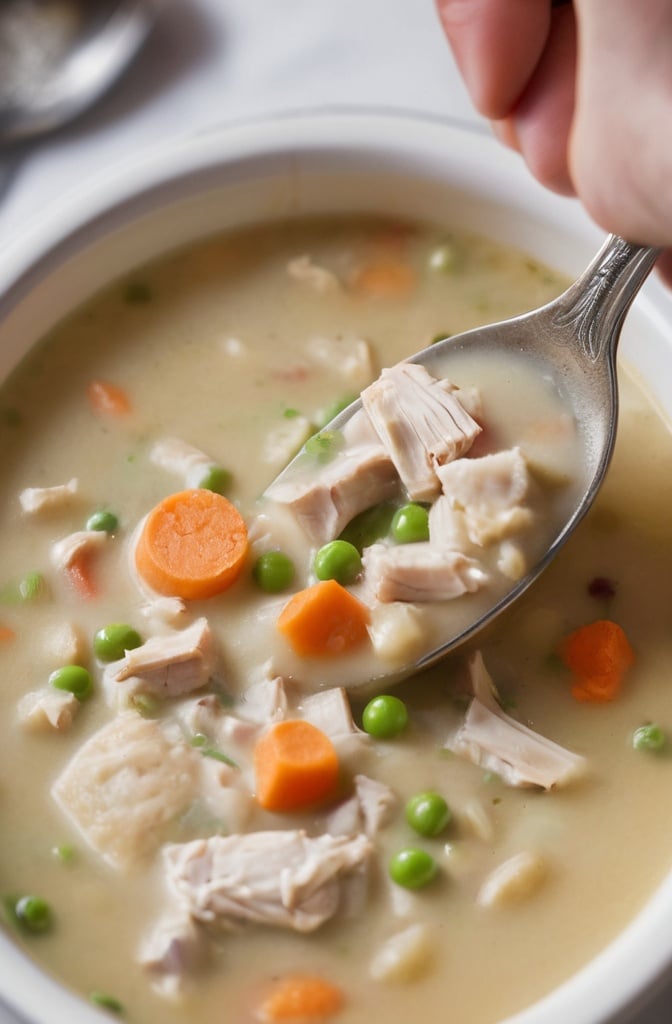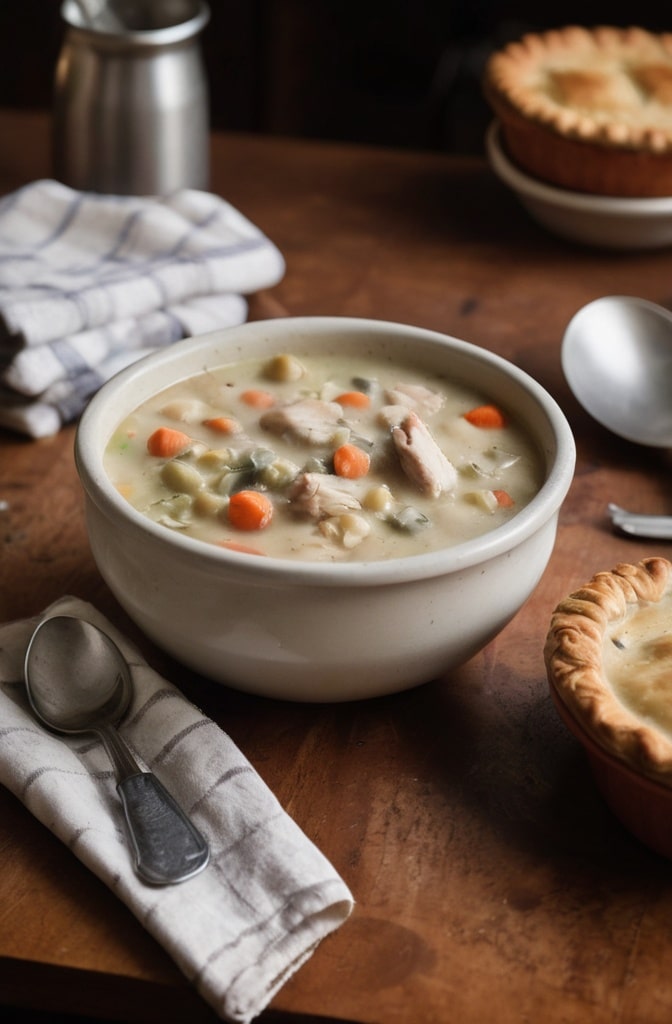Back in the icy winter of ’08, my restaurant faced a crisis that would change our menu forever. A massive snowstorm had delayed our deliveries, leaving us with limited ingredients and a full reservation list. Desperate times called for creative measures, and that night, Chicken Pot Pie Soup was born a happy accident that became our most requested dish for the next decade. Sometimes culinary magic happens precisely when your back’s against the wall.
Chicken Pot Pie Soup is the liquid embodiment of the classic comfort dish we all grew up with, minus the fussy pastry work. It captures that perfect balance of creamy richness, tender chicken, and sweet vegetables that makes traditional pot pie so irresistible, but in a spoonable format that’s simultaneously more elegant and more forgiving. What makes this dish truly special isn’t just its nostalgic flavor profile it’s the way it transforms humble ingredients through careful technique into something that feels both luxurious and homey at the same darn time.
Ingredients & Substitutions
For the Soup Base
- 3 tablespoons unsalted butter (or ghee for a nuttier flavor)
- 1 large yellow onion, diced small (about 2 cups)
- 3 medium carrots, diced (about 1 cup)
- 2 celery stalks, diced (about ¾ cup)
- 4 cloves garlic, minced
- ⅓ cup all-purpose flour
- 4 cups chicken stock (homemade preferred, but low-sodium store-bought works)
- 2 cups whole milk
- 1 teaspoon fresh thyme leaves (or ½ teaspoon dried)
- 1 bay leaf
- ½ teaspoon white pepper
- Sea salt to taste
For the Filling
- 2 pounds boneless, skinless chicken thighs, cut into 1-inch pieces
- 2 tablespoons olive oil
- 1 cup frozen peas
- 1 cup frozen corn kernels
- ¼ cup fresh parsley, chopped
For the Topping Options
- Puff pastry squares, baked separately
- Buttery pie crust rounds
- Homemade biscuits
- Crispy fried onions
- Herb dumplings (recipe variation below)
Thoughtful Substitutions
Dairy sensitivities? Replace the milk with unsweetened cashew cream or full-fat coconut milk both provide that luxurious mouthfeel without compromising the soup’s soul. The coconut adds a subtle sweetness that actually enhances the carrots and corn in unexpectid ways.
Gluten-free friends haven’t been forgotten. Swap the all-purpose flour with a good-quality cup-for-cup gluten-free blend, or for a more rustic approach, use rice flour mixed with a bit of tapioca starch (3:1 ratio). For thickening, you could alternatively use 2 tablespoons of cornstarch dissolved in cold stock just remember to add it towards the end of cooking since prolonged heat diminishes its thickening powah.
For the chicken, thighs are non-negotiable in my professional opinion. Breast meat simply doesnt provide the same richness, tenderness, or flavor when simmered. That said, if white meat is your preference, add it later in the cooking process and watch it like a hawk to prevent it from drying out. Rotisserie chicken makes a brilliant shortcut just fold it in at the end to warm through.
Step-by-Step Instructions

Preparing the Chicken (15 minutes)
- Pat chicken thighs dry with paper towels this is crucial for proper browning. Moisture is the enemy of caramelization, and that golden-brown color equals flavor compounds you don’t wanna miss.
- Season generously with salt and black pepper. Let the seasoned chicken rest at room temperature for 10 minutes before cooking, allowing the salt to penetrate beyond the surface and ensuring even cooking.
- Heat olive oil in a large Dutch oven over medium-high heat until shimmering but not smoking. Working in batches to avoid crowding (which causes steaming instead of searing), brown the chicken pieces for 2-3 minutes per side. They should be golden but not cooked through they’ll finish in the soup. Remove to a plate and set aside.
Building the Soup Base (20 minutes)
- In the same Dutch oven, melt butter over medium heat. Add the holy trinity of onions, carrots, and celery, cooking until the onions become translucent and vegetables begin to soften, about 5-7 minutes. Don’t rush this stage the slow release of vegetable sugars creates depth that defines great soup.
- Add garlic and cook just until fragrant, about 30 seconds. The cardinal sin is burnt garlic, which turns bitter and can ruin the entire pot. When you can smell the garlic’s aroma wafting up, move to the next step immediately.
- Sprinkle flour over the vegetables and stir constantly for 2 minutes, creating a blond roux. The flour should coat every piece evenly and lose its raw smell. This is your thickening foundation respect it by giving it your full attention.
Creating the Creamy Base (10 minutes)
- Gradually add chicken stock, whisking continuously to prevent lumps from forming. Pro tip: Keep the stock at room temperature or slightly warm, as cold stock hitting a hot roux creates lumps faster than you can say “where’s my immersion blender?”
- Pour in milk, continuing to whisk. Add thyme, bay leaf, and white pepper. White pepper isn’t just about aesthetics provides a different heat profile than black pepper, more subtle and pervasive without the speckled appearance.
- Bring mixture to a gentle simmer (never boil milk-based soups!), then reduce heat to medium-low and cook for 5 minutes until slightly thickened. A good consistency test: dip a wooden spoon into the soup, then run your finger across the back if it leaves a clear path that doesn’t immediately fill in, you’ve reached the perfect thickness.
Bringing It All Together (15 minutes)
- Return the browned chicken to the pot, including any accumulated juices that’s concentrated flavor you’re adding back. Simmer gently for 10-12 minutes, or until chicken is tender and cooked through. An instant-read thermometer should register 175°F for thigh meat.
- Add frozen peas and corn directly to the hot soup no need to thaw. Their residual coldness will help bring the soup to immediate serving temperature while they heat through, about 3 minutes. This preserves their color and prevents overcooking.
- Taste and adjust seasoning, remembering that the soup will continue developing flavor as it sits. Remove bay leaf, stir in fresh parsley, and prepare to serve. If the soup seems too thick, add a splash of stock; too thin, simmer uncovered for a few more minutes.
The Topping Element (Varies based on choice)
For maximum enjoyment, I recommend baking puff pastry squares separately (400°F for 15-18 minutes until golden and flaky) rather than floating dough on top of the soup. This preserves the textural contrast between crisp pastry and creamy soup—an element often lost when the pastry soaks up too much liquid.
For herb dumplings, combine 1 cup flour, 2 teaspoons baking powder, ½ teaspoon salt, 2 tablespoons cold butter (cut in until crumbly), and ¼ cup chopped herbs. Add ½ cup milk, drop by spoonfuls onto simmering soup, cover, and cook 15 minutes without peeking. The cardinal rule of dumplings: “If you’re lookin’, they’re not cookin’!”
Cooking Techniques & Science
The Truth About Roux
The roux in this soup isn’t just a thickening agent it’s a flavor foundation. When flour particles are coated with fat and gently cooked, they undergo a transformation that eliminates the raw flour taste while creating toasted notes that add complexity. Additionally, the starch granules’ ability to absorb liquid creates that silky mouthfeel impossible to achieve with cornstarch or other thickeners.
For chicken pot pie soup, we want a blond roux (cooked just until the raw flour smell dissipates) rather than the darker roux used in gumbos or étouffées. The lighter cook preserves the thickening power while maintaining the clean, creamy color essential to the dish’s identity. Each level of browning sacrifices some thickening ability in exchange for deeper flavor a trade-off that wouldn’t serve this particular soup well.
The science here is fascinating: when the soup simmers, the starch molecules in the flour swell and form a complex matrix that creates viscosity. This matrix also prevents fat molecules from coalescing, resulting in that perfectly emulsified, velvety texture that coats the back of a spoon and, more importantly, your palate.
Layering Flavors Through Fond
That crusty brown residue left after searing the chicken? That’s fond, and it’s concentrated umami gold. By building the soup in the same pot where you’ve browned the meat, you’re incorporating those Maillard reaction compounds back into your liquid. This isn’t just cheffy showmanship it’s fundamental to creating depth.
The Maillard reaction (named after the French chemist who first described it) occurs when proteins and sugars are exposed to high heat, creating new flavor compounds. These molecules provide the distinctive savory quality that makes browned foods so irresistible. By deglazing the fond with your aromatics and stock, you’re dissolving these compounds back into the soup, creating a flavor foundation impossible to achieve with raw ingredients alone.
Temperature Management
The most common mistake in creamy soups is aggressive boiling, which causes dairy to separate and gives a grainy texture no amount of whisking can fix. Keeping the soup at a gentle simmer just enough movement to see occasional bubbles breaking the surface protects the emulsion and prevents curdling.
When adding cold ingredients to a hot base, temperature shock can also cause separation. This is why we add room-temperature or warm stock to our roux, and why commercial kitchens always temper cold dairy by gradually introducing small amounts of hot liquid before adding it to the main pot. These aren’t fussy chef techniques; they’re insurance policies against textural disasters.
Serving & Pairing Suggestions

Elegant Presentation
For an upscale presentation worthy of a bistro, serve the soup in wide, shallow bowls that showcase the colorful vegetables. Place your chosen pastry element slightly off-center, partially submerged but with a corner proudly rising above the soup’s surface. A light dusting of paprika and a small sprig of fresh thyme creates a professional finish without appearing overthought.
For family-style service, a tureen with pastry squares served alongside allows guests to construct their own experience preserving the crucial textural contrast until the moment of consumption. Pre-warming bowls is non-negotiable; the temperature drop from a cold bowl can transform your carefully crafted soup into a tepid disappointment in minutes.
Complementary Pairings
This soup walks the line between homey and sophisticated, making it versatile for pairing. A crisp sauvignon blanc cuts through the richness with its acidity, while a lightly oaked chardonnay complements the creamy texture. For beer enthusiasts, a Belgian-style wheat beer with its subtle citrus notes offers refreshing contrast.
On the non-alcoholic front, sparkling water with a squeeze of lemon performs the same palate-cleansing function as white wine. Unsweetened iced tea with a sprig of mint also provides a clean counterpoint to the soup’s richness.
For side dishes, resist the urge to over-complicate. A simple green salad dressed with a sharp vinaigrette provides textural and flavor contrast. If serving as a starter, keep portions modest (about 6 ounces) and follow with a light main course like roasted fish or a seasonal vegetable tart.
Make-Ahead and Storage Tips
Like many soups, chicken pot pie soup actually improves after an overnight rest in the refrigerator, as flavors meld and deepen. If making ahead, prepare through adding the chicken but hold back the peas, corn, and parsley. Cool completely (never put hot soup directly into the refrigerator a food safety issue and an energy waster), then refrigerate up to 3 days.
When reheating, warm gently over medium-low heat, stirring occasionally, until it reaches a simmer. Then add the reserved vegetables and herbs. This two-stage approach preserves the bright color and texture of the vegetables while allowing the base to develop complexity.
For freezing, omit the dairy entirely, freezing just the stock-based soup with chicken and vegetables. When ready to serve, thaw completely, reheat gently, and add freshly warmed milk or cream. This prevents the dreaded grainy texture that frozen dairy often develops—a professional workaround that makes all the difference.
Conclusion
Chicken Pot Pie Soup represents the best of comfort food evolution taking a beloved classic and reimagining it in a form that’s simultaneously more accessible and more refined. By understanding the techniques that build flavor and texture proper searing, roux development, temperature control you transform simple ingredients into a dish that satisfies on multiple levels.
The true magic happens in those careful details: the gentle browning of chicken that creates fond, the patient cooking of aromatics that releases their sweetness, the respectful treatment of dairy that preserves silky texture. These aren’t cheffy flourishes; they’re fundamental techniques that separate mediocre soups from memorable ones.
Whether served as a elegant first course for guests or a hearty family dinner, this soup adapts to your needs while maintaining its essential character. Its forgiving nature makes it perfect for newer cooks, while the opportunity for technical precision satisfies professionals. Most importantly, it delivers that intangible quality all great food shares—the ability to create not just satisfaction, but joy. And in the end, isn’t that why we cook in the first place?
FAQs
Can I make this soup vegetarian?
Absolutely! Replace the chicken with 2 cups of diced king oyster mushrooms and 1 cup of cubed firm tofu. The mushrooms provide umami and meaty texture, while tofu adds protein. Use vegetable stock instead of chicken stock, and add ¼ teaspoon of smoked paprika to contribute depth typically provided by animal proteins.
For the mushrooms, sear them well in butter until golden before proceeding with the recipe this develops their flavor significantly and prevents them from becoming waterlogged during simmering.
Why did my soup separate and how can I fix it?
Separation typically happens when dairy-based soups boil or experience extreme temperature shifts. To fix an already-separated soup: 1) Remove from heat immediately. 2) Transfer a cup of the soup to a blender and add 1 tablespoon of cold butter.
Blend until smooth, then gradually whisk this mixture back into the main pot off the heat. 3) Once reincorporated, very gently rewarm over low heat. Prevention is easier than cure keep soups containing dairy at a gentle simmer below 180°F and avoid sudden temperature changes.
Can I use rotisserie chicken to save time?
Smart thinking! Rotisserie chicken makes a fantastic shortcut for busy weeknights. Shred or dice about 3 cups of meat (a mix of white and dark provides best flavor) and add it after your soup base has simmered.
Since the chicken is already cooked, it only needs to be warmed through. Bonus tip: simmer the rotisserie carcass in water for 30 minutes to create a quick stock that adds remarkable depth to your soup professional chefs use these kinds of layering techniques constantly.
How do I prevent my pastry toppers from becoming soggy?
The key is separation until service. Bake puff pastry squares, pie crust rounds, or biscuits separately on a parchment-lined baking sheet until fully cooked and golden. Store at room temperature if serving within a few hours, or rewarm in a 300°F oven for 5 minutes just before serving.
Place the hot pastry on the soup at the last possible moment, preferably at the table. For make-ahead convenience, you can freeze fully baked pastry pieces, then refresh in a hot oven directly from frozen they’ll taste freshly made.
How can I make the soup thicker (or thinner)?
For a thicker soup, create a beurre manié by kneading together equal parts soft butter and flour (try 1 tablespoon of each). Whisk this paste bit by bit into the simmering soup until you reach desired consistency. The cold butter coating the flour prevents lumps while adding richness.
For a thinner soup, whisk in additional warm stock or milk. Remember that all flour-thickened soups continue to thicken as they cool and after refrigeration, so make adjustments considering when you’ll serve it. Professional kitchens often keep soup slightly thinner than ideal since it will set up more during holding and service.

